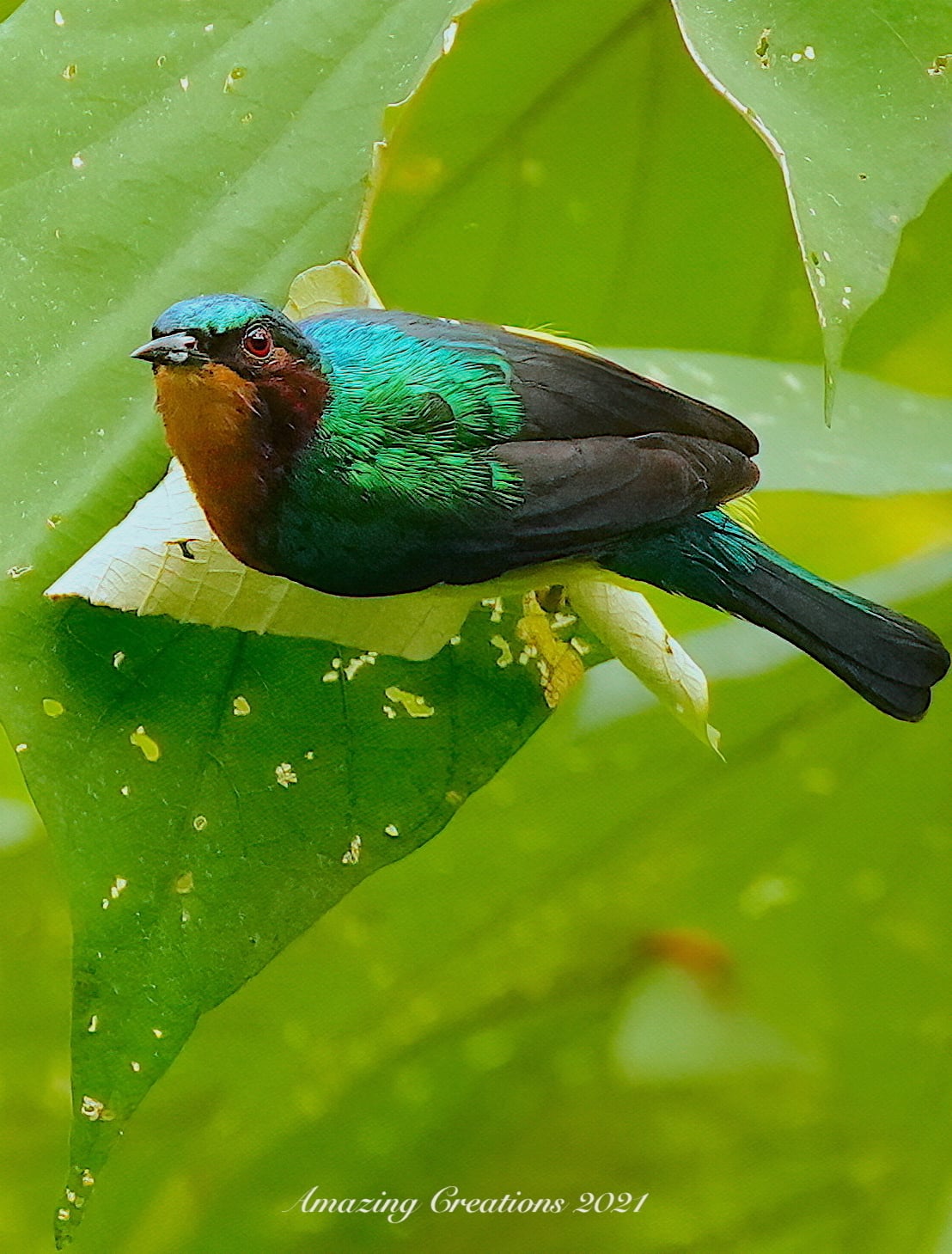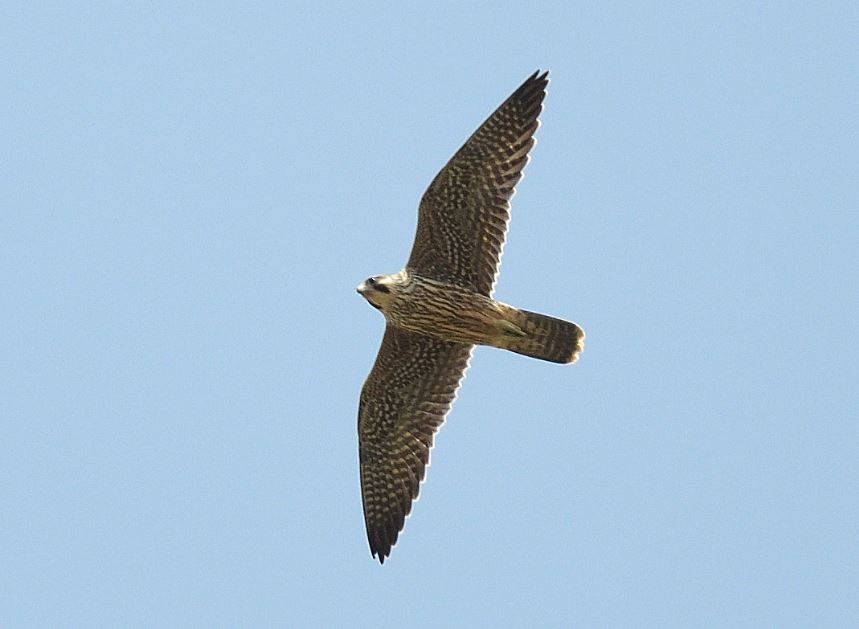by Geoff Lim & Isabelle Lee, and Tan Gim Cheong (ed.)
Reports of migratory birds continue to surface in social media and eBird, including the surprise find of a rare Red Knot at Yishun Dam, and elsewhere, the Oriental Plover, and Red-necked Phalarope.

Red Knot with Lesser Sand Plover at Yishun Dam taken on 6 September 2021 by Vincent Yip.
Central Catchment Nature Reserve (CCNR) & vicinity
An Oriental Darter, Anhinga melanogaster, was spotted at Singapore Quarry on 12 Sep 2021 by Lua Wai Heng, while two Cinnamon-headed Green Pigeon, Treron fulvicollis, were seen by Robin Arnold on 18 Sep 2021 at Jelutong Tower. Blue-rumped Parrots, Psittinus cyanurus, were also seen within the confines of Windsor Nature Park on 29 Sep 2021 by Lee Yue Teng. At Dairy Farm Nature Park on 30 Sep 2021, Gan Lee Hsia photographed a Dark-sided Flycatcher Muscicapa sibirica, and Vincent Yip photographed a Ferruginous Flycatcher Muscicapa ferruginea.
Singapore Botanic Gardens
Notable sightings from this UNESCO heritage park comprised an Amur Paradise Flycatcher, Terpsiphone incei, (Andy Lee) and a Brown-streaked Flycatcher, Muscicapa williamsoni, (BP Chua) on 11 Sep 2021, a Malaysian Hawk-Cuckoo, Hierococcyx fugax, on 17 Sep 2021 (Oliver Tan) and seven Ruddy-breasted Crake, Porzana fusca, on 28 Sep 2021 (Colin Lee) at the NUS Faculty of Law drop-off point.
Northern Singapore
A surprise visit by a solitary Red Knot, Calidris canutus, on 6 Sep 2021 at Yishun Dam (Vincent Yip) had many scrambling to see this rarity, while a Gull-billed Tern, Gelochelidon nilotica, visited the waters on 10 Sep 2021 (Chen Boon Chong). The mudflats also welcomed a Greater Sand Plover, Charadrius leschenaultii, which was reported on 14 Sep 2021 (Sylvester Goh).

Ruby-cheeked Sunbird at SBWR on 4 September 2021, by Joseph Lim.
Visitors to the Sungei Buloh Wetland Reserve spotted a Ruby-cheeked Sunbird, Chalcoparia singalensis, on 4 and 5 Sep 2021 (Joseph Lim and Norhafiani A Majid, respectively), a Blue-eared Kingfisher, Alcedo meninting, on 15 Sep 2021 (Kwok Siew Mun), a pair of Marsh Sandpiper, Tringa stagnatilis, on 19 Sep 2021 (Darren Leow), two Broad-billed Sandpiper Calidris falcinellus, on 24 Sep 2021 (Pary Sivaraman), and a Terek Sandpiper, Xenus cinereus, on 29 Sep 2021 (BP Chua). There were also 2 Lesser Adjutants, Leptotilus javanicus, on 3 Sep 2021, by Veronica Foo.
Eastern Singapore
Visitors to Pasir Ris Park were treated to the sight of a Terek Sandpiper, Xenus cinereus, on 1 Sep 21 (Ko Eng Wee), three Black-throated Laughingthrush, Pterorhinus chinensis, on 19 Sep 2021 (Frank Chen) and a Japanese Sparrowhawk, Accipiter gularis, on 20 Sep 2021 (Philip Chua). On an offshore area in the northeast undergoing land reclamation, a Great Knot Calidris tenuirostris was recorded on 10 Sep 2021 by Frankie Cheong.
Southern Singapore

Grey-rumped Treeswift chick taken on 17 September 2021 by Geoff Lim.
A number of Grey-rumped Treeswift, Hemiprocne longipennis, were reported on and around 16 Sep 2021 (Lee Chin Pong) at Margaret Drive, including a nest bearing a chick, which subsequently fledged on 22 Sep 2021. At Pinnacle@Duxton, a Blue Rock Thrush Monticola solitarius (philippensis subspecies) was photographed on 16 Sep 2021 by Angie Cheong.

Blue Rock Thrush, Pinnacle@Duxton, on 16 September 2021 by Angie Cheong.
Western Singapore
Migratory woodland species reported at Jurong Lake Gardens included one Yellow-rumped Flycatcher, Ficedula zanthopygia, seen on 13 Sep 2021 by Andy Lee, and one Oriental Dwarf Kingfisher (Black-backed) Ceyx erithaca photographed by 29 Sep 2021 by Gan Lee Hsia.
At Tuas South, two Black-winged Stilt, Himantopus himantopus, were photographed on 3 Sep 2021 by Mike Hooper, and an Oriental Plover, Charadrius veredus, photographed on 20 Sep 2021 by Pary Sivaraman. At nearby Tuas South Boulevard, Max Khoo spotted an Indian Cuckoo, Cuculus micropterus, on 25 Sep 2021.
A Ruddy Kingfisher, Halcyon coromanda, was seen on 15 Sep 2021 at Nanyang Technological University by Frank Chen, and one Green-backed Flycatcher, Ficedula elisae, was found dead (likely collided into a building) at National University of Singapore on 30 Sep 2021 by Li Daiqing.
Straits of Singapore
Three pelagic trips were undertaken this month. On 21 Sep 2021, there were 11 sightings of the Aleutian Tern Onychoprion aleuticus, two Bridled Tern Onychoprion anaethetus, and nine Greater Crested Tern, Thalasseus bergii (Con Foley). On 25 Sep 2021, two Black-naped Tern, Sterna sumatrana, (Oliver Tan) and a number of Swinhoe’s Storm Petrel, Oceanodroma monorhis, (Krishna Gopagondanahalli) were spotted along the Singapore Straits and off Kusu Island, respectively, while those on 26 Sep 2021 saw one Lesser Crested Tern, Thalasseus bengalensis, thirteen Aleutian Tern, Onychoprion aleuticus, eleven Bridled Tern, Onychoprion anaethetus, and five Greater Crested Tern, Thalasseus bergii, (Adrian Silas Tay).
Lau Jia Sheng spent four weekends in September on Kusu Island watching seabirds and reported 6 Red-necked Phalaropes Phalaropus lobatus on 4 Sep 2021. He had amazing counts of the Swinhoe’s Storm Petrel, Hydrobates monorhis, starting with 39 petrels on 4 Sep 2021, to 203 petrels on 11 Sep 2021, peaking at 800 petrels on 18 Sep 2021, followed by 418 petrels on 25 Sep 2021.
This report is compiled/written by Geoff Lim and Isabelle Lee, and edited by Tan Gim Cheong. We are grateful for the birders and photographers whose postings in various Facebook birding pages, bird forums, individual reports and extracts from eBird make up this report. This compilation is not a complete list of birds recorded for the month and not all the records were verified.
Many thanks to Vincent Yip, Joseph Lim, Geoff Lim and Angie Cheong for allowing us to use their photographs.





























